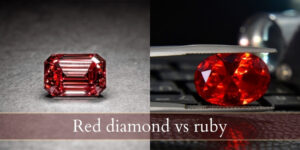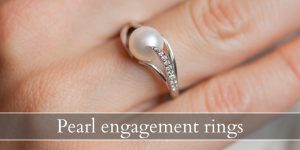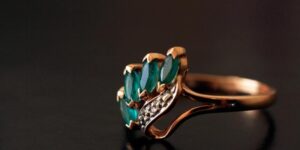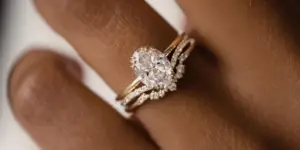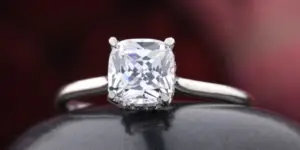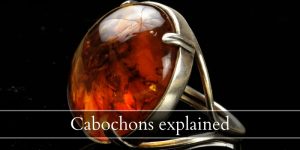Interested in wearing some beautiful green gemstones ? Or maybe you just love the idea of emeralds and want to know what else is there in the luscious world of mossy green gems ? The following list takes into account the green gemstones that are strong enough to be worn in jewelry so you can discern which you’d like best.
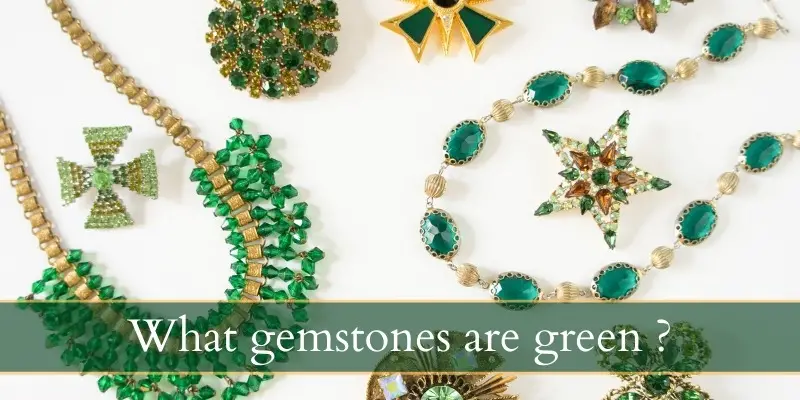
1. Green diamond
Green diamonds are not the first option you may think of, but they’re very real and very good candidates for a green gemstone. These diamonds are not very easy to find, but if you’re patient a jeweler may be able to source one for you.
Color: green diamonds are indeed green but they’re not a very vivid green. Some can look almost as vivid as an emerald, but those are quite rare. Most of the time green diamonds are grey-green, or yellow-green, or a combination of grey-yellow-green. This means they won’t steal the show with their impressive color, but they will still sparkle a whole lot, almost as much as a clear diamond (almost).
Price: green diamonds are priced by their color and less by how included they are. So the more vivid green ones sell for about $800,000 per carat while the the paler one go for $300,000 per carat usually. The paler ones are the most common green diamonds, so that’s what you’re most likely to find.
Hardness: green diamonds are still diamonds, so they score a 10/10 on the Mohs scale of hardness. This makes them nearly indestructible, unless you have another diamond nearby. You can wear green diamonds however you like, they will stand up to wear and tear just fine.
2. Green sapphire
Green sapphires are also a bit of a shock, just like green diamonds. We all know diamonds are white and sapphire are blue. But here come green sapphires to throw everyone off. Well it’s true, they can be green and they’re a very special kind of green that you won’t easily find in any other gemstone on this list.
Color: green sapphires have a distinct blue hue to them that makes them stand out from all other green gems. Sometimes the blue can make the green sapphires appear a bit grey. In some lower-quality green sapphires you’ll find a yellow hue instead of a blue one, making them resemble a washed out peridot. But compared to green diamonds you’ll find that green sapphires are definitely more vibrant in color. Unfortunately green sapphires cannot be a bright, vivid green like an emerald.
Price: green sapphires sell for an average of $2,500 per carat, with better color one fetching slightly higher prices. Inclusions don’t seem to matter as much for green sapphires, instead the blue hues tend to be more appreciated.
Hardness: green sapphires are still corundum and as such they score a 9 on the Mohs scale. This makes them a very tough material that will easily survive daily wear and tear and not need extra polishing for several years at a time. This is a very tough gem that can be handed down to your children and grandchildren without losing its shine and color.
3. Emerald
Emeralds are the green gem, the one everyone first thought of when we started this list. Not only are these gems beautiful they come with a whole lot of legend and history to them, some of them pretty wild. No matter what, emeralds are impressive and quite easy to find at a jeweler since they’re always in high demand.
Color: if green is what you’re after then emerald will deliver. A deep green color with only the slightest hint of blue to it, and sometimes no blue at all, just pure green. Really, emeralds are the most vibrant green gems you can find, and they look like they should smell of mint.
Price: emeralds sell for an average of $18,000 per carat, for a vibrant green color and eye-clean or very very slightly included clarity. You can find emeralds for much more and much less, but that is the average price. All emeralds are included in some way, so if you keep finding included ones remember that getting an eye-clean one is rare and quite expensive.
Hardness: these gems are not the toughest, but they can still be worn every day, just maybe not in a ring or bracelet. Emeralds have a Mohs rating of 7.5-8 due to their many inclusions that make them prone to chipping and scratching. We recommend you take a bit of care when wearing emeralds daily, or perhaps options for a pendant or a pair of earrings.
4. Peridot
Peridots are a whole new level of green gemstone, and they’re pretty easy to get a hold of as well. They’re quite well known, even if they’re not as sought-after as emeralds.
Color: when it comes to peridot you shouldn’t expect your typical green with hints of blue, Instead this gem shows a lime green color. It has a bright green with significant yellow hue, like a fresh spring leaf, or blades of grass in the sun. There is nothing mysterious or moody about peridot, no sir ! These gems scream bright green at you and they brighten up any jewelry.
Price: peridots are far more affordable than the first few green gems on this list, though they do offer a different kind of green. Peridots sell for an average of 160$ per carat for a bright color gem with eye-clean clarity. If you don’t mind the yellow hue or you’re not looking for a specific shade of green then peridot my just fit the bill.
Hardness: peridots are softer than emeralds, as they score a 6.5-7 on the Mohs scale. This means you should be very careful with your jewelry if you intend to wear peridots on a daily basis. Any rings or bracelets with peridots in they will accumulate scratches and get cloudy in time, so perhaps only wear those occasionally.
5. Green tourmaline
Tourmaline is another green gemstone that is quite easy to find. It seems that green is not a difficult color to find in gems, unlike pink or orange. Green tourmaline is the most common version of tourmaline, but be warned. Jewelers and retailers tend to carry more of the pink tourmaline than the green, because pink tourmaline is October’s birthstone, and not as many people ask for green.
Color: green tourmaline comes in many green shades, with the most common ones being an olive green color and emerald green. The olive green is usually a bit on the medium-dark side. The green in this version is not the most vibrant and it often has a golden hue to it. The emerald green version also has a medium-dark green but with almost no gold hue in it.
Price: green tourmaline sells for an average of $200 per carat and generally comes pretty clear, so it doesn’t show many inclusions.
Hardness: tourmaline is a 7 on the Mohs scale of hardness, so like peridot it might not be a good idea to wear it every single day if you’re not ready to have it re-polished every few years. Occasional wear is fine.
6. Green garnet
Garnets are very well known for being red, in fact they’re often used as dupes for rubies. So it’s quite interesting when you find a green garnet, and a very vibrant color one at that. Garnets actually come in several colors, and green in one of them. You’ll have an easier time finding red garnets but with a bit of patience you can source a green one as well. Tsavorite and uvarovite are two of the names for green garnet.
Color: the green in a green garnet tends to have a slight yellow hue. Sometimes you can find a pure green one, much like an emerald without its blue hue. But most of the time a green garnet will have at least some amount of yellow in it. But the yellow makes it a very bright gem, so a green garnet will be bright, vivid, and hard-to-miss green.
Price: green garnets sell for $700 per carat, which doesn’t make them cheap but they do seem to be an affordable alternative to emeralds (if you can find the pure green ones).
Hardness: garnets average a 7 on the Mohs scale so they will accumulate some scratches and possibly chip if worn every single day. We recommend a pendant or a pair of earrings if you want green garnet.
7. Prasiolite (green quartz)
Prasiolite in simply a form of green quartz, in the same family as amethyst (purple quartz). But very few people call it prasiolite, so you may find it listed as green amethyst. This is a far rarer version of quartz, though quartz is not a rare mineral at all, it’s actually quite common. It just happens to be more common in purple, and then yellow (citrine).
Color: prasiolite is a very light, pale kind of green. It’s not a vibrant green so it would suit a pastel or light color themed jewelry better. Sometimes prasiolite can have a yellow hue to it. This is also a very clear gemstone, similar to aquamarine or morganite.
Price: prasiolite is very cheap, a bit less than amethyst. It averages at about $4 per carat, and you can find it in all sizes.
Hardness: prasiolite is a type of quartz, and as such it scores a 7 on the Mohs scale. Like garnets and tourmalines, you should keep all quartz (including prasiolite) out of harm’s way and not wear them daily.
8. Jade
Jade is an ancient green gemstone, known to many civilizations but it was especially important in South-East Asia and Latin America. Jade comes in several colors but it’s most well known for its green coloration. In truth the name jade is applied to two very different minerals: jadeite and nephrite, which look and behave very similarly. For this list we’re taking a closer look at jadeite, as it’s the one that most typically shows a vibrant green hue.
Color: Jade tends to show very wide range of green, from creamy white to light green to dark green, sometimes with a hint of yellow. Some jade specimens can reach a green as vivid and impressive as an emerald. In some cases you can’t even tell the difference between jade and heavily included emerald. Jade does tend to be nearly opaque.
Price: Jade has a very wide price range, all the way form $6 per carat to $100 per carat depending on color intensity. There is a lot of fake jade on the market, or poor quality jade that was dyed and polished and filled, and these will always sell very cheap. Buying real jade is actually tricky.
Hardness: Jade averages a 6.5 on the Mohs scale of hardness so it’s best to wear this gem as a necklace, brooch, or a pair of earrings. Jade rings or bracelets will pick up a lot of scratches.
9. Malachite
Malachite is a type of copper carbonate, hence the deep green-blue color. This is a type of mineral that is not well known in jewelry, and is most often used for ornamental purposes like vases, carved objects, or masks.
Color: Malachite comes in a deep, velvety green colors and in some cases it’s formed by millions of tiny needle-like structures which give it a texture similar to velvet and produce far lighter and darker shades of green. Most of the time you will see malachite cabochons with bands of darker and lighter green.
Price: Malachite is quite affordable, selling for an average of $2 per carat. If you’re looking for very large gems malachite is easy to find in large amounts.
Hardness: Malachite has a Mohs score of 3.5 which puts it squarely in the earrings or pendant zone. Do not wear this gem every single day, and be very mindful not to sweat in it.
What metal do green gems go with ?
Green gemstones go best with yellow or white metals, so yellow gold, white gold, platinum, and silver are all great options for a green gemstone. Yellow metals in particular seem to go great with green gems, and they have a bit of a vintage and luxurious vibe to them due to the color combination.
We don’t recommend rose gold with green gems, simply because the pink tends to clash with the green, even if you have a halo of white gems all around the green one.

I’m the main author for jewelrymaterialguide.com. I started this site after we did tons of research before our wedding and noticed that there is information about rings, jewelry, and so on that is really hard to find on the internet.

